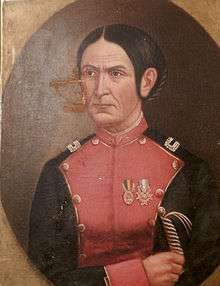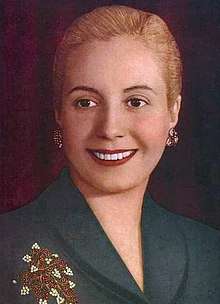Women in Argentina
The status of women in Argentina has changed significantly following the return of democracy in 1983; and they have attained a relatively high level of equality. In the Global Gender Gap Report prepared by the World Economic Forum in 2009, Argentine women ranked 24th among 134 countries studied in terms of their access to resources and opportunities relative to men.[5] They enjoy comparable levels of education, and somewhat higher school enrollment ratios than their male counterparts. They are well integrated in the nation's cultural and intellectual life,[6] though less so in the nation's economy. Their economic clout in relation to men is higher than in most Latin American countries, however,[7] and numerous Argentine women hold top posts in the Argentine corporate world;[8] among the best known are Cris Morena, owner of the television production company by the same name, María Amalia Lacroze de Fortabat, former CEO and majority stakeholder of Loma Negra, the nation's largest cement manufacturer, and Ernestina Herrera de Noble, director of Grupo Clarín, the premier media group in Argentina.
 Ex President of Argentina is a woman | |
| Gender Inequality Index | |
|---|---|
| Value | 0.358 (2017)[1] |
| Rank | 81st |
| Maternal mortality (per 100,000) | 34.9 (2017)[2] |
| Women in parliament | 40% (2019)[3] |
| Females over 25 with secondary education | 65.9% (2010)[1] |
| Women in labour force | 47.3% (2017)[1] |
| Global Gender Gap Index[4] | |
| Value | 0.746 (2020) |
| Rank | 30th out of 149 |
Argentine women, however, continue to face numerous systemic challenges common to those in other nations. Domestic violence in Argentina is a serious problem, as are obstacles to the timely prosecution of rape, the prevalence of sexual harassment, and a persistent gender pay gap, among other iniquities.[9]
Historical context
Nineteenth Century

In the early nineteenth century, the Spanish crown ruled the region now encompassed by the modern countries of Argentina, Uruguay, and Paraguay, via the viceroyalty of Río de la Plata, with the capital in Buenos Aires. With the Napoleonic invasion of Spain in 1808, areas of the viceroyalty rose in revolt.

One of the participants in the wars for independence was Juana Azurduy, who is honored now by both Bolivia and Argentina as contributing to independence.[10] In 2009, Argentine President Cristina Fernández de Kirchner promoted Azurduy to the rank of general in the Argentine army from lieutenant colonel. The Argentine army named an infantry regiment based in the northern region of Salta as "Generala Juana Azurduy." In June 2014, President Fernández de Kirchner unveiled the new Argentine 10-peso note with the image of Azurduy.[11]
Argentina in the early nineteenth century had few cities, but the port of Buenos Aires grew from a backwater of the Spanish empire into a major port in the late eighteenth century. Rural areas in Argentina were sparsely populated by the indigenous Mapuche and gauchos, mixed race men on horseback who hunted free-range cattle for their hides and to make dried beef. Non-indigenous women on the vast Argentine pampas were few, and depicted in art as vulnerable to abduction by "barbarian" Indians.
Twentieth Century


During the 1930s, Fanny Edelman, a Communist leader who was part of the International Brigades in defense of the Second Spanish Republic, became an international figure representing Communism and Feminism. She participated to the creation of the Women's Union of Argentina in 1937, and in 1972 she became head of the Women's International Democratic Federation. She was honorary president of the Communist party of Argentina until her death in 2011.[12][13]
Following President Juan Perón's enactment of women's suffrage in 1949, First Lady Evita Perón led the Peronist Women's Party until her death in 1952, and helped enhance the role of women in Argentine society. Women played a significant role as both supporters and opponents of the National Reorganization Process, Argentina's last dictatorship, in the late 1970s, and the establishment of the Mothers of the Plaza de Mayo, an advocacy group led by mothers of the disappeared, was done by Azucena Villaflor de Vicenti and, mostly, other women, on the rationale that they would be less likely to be the targets of repression (Villaflor de Vicenti and her fellow founders were murdered by the regime in 1977).[14] Women's rights in Argentina progressed in significant ways following the return of democracy in 1983. President Raúl Alfonsín signed laws in 1987 both limiting Patria potestas (the latitude given to a father regarding his treatment of fellow household members, particularly children) and legalizing divorce, helping resolve the legal status of 3 million adults living in legal separation.[15] The Argentine quota law signed by President Carlos Menem in 1991 provides that one-third of the members of both houses of congress must be women, a goal achieved through balanced election slates.[16] As of 2006, there were 29 women in the 72-seat Senate, 86 women in the 257-seat Argentine Chamber of Deputies, two female Supreme Court justices, and three women in the presidential cabinet.[16] The President of Argentina, Cristina Fernández de Kirchner was elected in 2007; the runner-up in the crowded field was also a woman, Elisa Carrió.
Family life
With regard to the organization of family life, Argentina has a history of social conservatism, and the influence of Catholicism in Argentina has been very strong throughout the 20th century. In Argentina, divorce was legalized only in 1987, and the legalization was the result of a struggle between different governments and conservative groups, mostly connected to the Catholic Church, that lasted a whole century. In 1987, President Raúl Alfonsín was successful in passing the divorce law, following a ruling of the Supreme Court. The new law also provided for gender equality between the wife and husband.[17] By 1987, when divorce was legalized, only three other Latin American countries prohibited divorce (Paraguay and Colombia, which legalized it 1991,[17] and Chile which legalized it in 2004[18]). Adultery was decriminalized in 1995.[19] Also, a new Civil and Commercial Code,[20] modernizing family law, came into force in August 2015.[21][22]
Domestic violence
Violence against women is a serious problem in Argentina. Amnesty International reported in February 2012 that a woman died every two days as a result of domestic violence in Argentina.[23] The civil society organization La Casa del Encuentro reported that between January and September 2013, 209 women died as a result of domestic or gender-based violence.[9]
In 2009, Argentina enacted Ley de protección integral para prevenir, sancionar y erradicar la violencia contra las mujeres en los ámbitos en que desarrollen sus relacion es interpersonales [Ley 26.485][24] (The Comprehensive Law on the Prevention, Punishment and Elimination of Violence against Women in their Interpersonal Relations [Law 26.485]).
In November 2012, the Congress passed an anti femicide law imposing stricter penalties on perpetrators who kill their spouses, partners, or children as a consequence of gender based violence.[9]
According to the Human Rights Watch’s 2018 world report, 254 femicides were reported, but only 22 convictions were done in 2016.[25]
Human trafficking
While individual prostitution is legal in Argentina, the promotion, facilitation, or forcing of people into prostitution is illegal. Argentina is a source, transit, and destination country for sex trafficking of women. Sex trafficking victims often come from Paraguay and the Dominican Republic.[26]
Rape and sexual harassment
Sexual harassment in the public sector is prohibited and is subject to disciplinary or corrective measures. In some jurisdictions, such as Buenos Aires City, sexual harassment may lead to the abuser’s dismissal, but in others, such as in Santa Fe Province, the maximum penalty is five days in prison.[9]
The law prohibits rape, including spousal rape; but the need for proof, either in the form of clear physical injury or the testimony of a witness, has often presented difficulties in prosecuting such crimes. Women’s rights advocates have accused the police, hospitals, and courts of hostile attitudes against victims of sexual violence.[9]
The 2009 law on violence against women (Law 26.485) has comprehensive provisions against sexual violence, including sexual violence within marriage (in particular Article 5(3)[27]).
Before a change in law in 1999, sexual offenses were classified as "Offences against honesty", and the concept of "honest woman" appeared in certain sexual crimes. Act No. 25,087 of 1999 (Ley N° 25.087) reformed the legislation, and changed its name to "Offences against sexual integrity".[28][29]
Economic gender gap

Although since the 1869 enactment of the Argentine Civil Code, all citizens are considered equal, and the Constitution of Argentina also states at Section 16 that "The Argentine Nation admits neither blood nor birth prerogatives: there are neither personal privileges nor titles of nobility. All its inhabitants are equal before the law, and admissible to employment without any other requirement than their ability. Equality is the basis of taxation and public burdens",[30] women often encounter economic discrimination and hold a disproportionately higher number of lower-paying jobs. Approximately 70 percent of women employed outside the home work in unskilled jobs, although more women than men hold university degrees.[16] According to a 2007 study by the Foundation for Latin American Economic Research (FIEL), men earned 5 percent more than women for equivalent full-time work in the Greater Buenos Aires area, and earned 21 percent more than women for equivalent part-time work, an imbalance explicitly prohibited by law: prison terms of up to three years can be issued for discrimination based on gender.[16]
Restrictions on abortion


Abortion in Argentina remains prohibited, and is legal only in cases of rape, or where the life of the mother is in danger.[31] The Argentine Penal Code 846, moreover, was amended in 2008 to place stricter sanctions against women who seek an abortion, as well as any medical staff involved in the act.[32] These limitations notwithstanding, an estimated 500,000 abortions are performed annually in Argentina (compared to around 700,000 live births), resulting in at least 10,000 hospitalizations due to complications[33] (estimates vary widely)[34] and around 100 deaths (a third of all maternal mortality).[35][36]
Contraception and reproductive rights
Traditionally, access to contraceptives has long been discouraged by a succession of Argentine governments,[37] which instead rewarded large families with subsidies rising disproportionately with the seventh child.[38] Although Argentine women have long had among Latin America's lowest birth rates (averaging 2.3 births per woman in recent years), the policy has tended to encourage higher birth rates in the lowest strata of society (including women least able to afford large families).[38] Contraceptives are widely used by sexually active Argentine women, as condoms are by Argentine men, and a variety of birth control products can be obtained freely in pharmacies;[39] the Argentine government began their free distribution in 2003.[37] In general, couples and individuals have the right to decide freely the number, spacing, and timing of children, and have access to information and reproductive health services. The law requires the government to provide free contraceptives.[9]
Women in politics
Traditionally, politics was seen a male domain. The legal and social roles of women in Argentina were mostly dictated by the Spanish Law (which itself was based on Roman law) and by the Catholic Church. As such, women were subordinated first to their fathers and then to their husbands.[40] Today, however, women have a notable presence in Argentinian politics, and they make up more than a third of the parliament.[41] Argentina had two female presidents: Isabel Martínez de Perón and Cristina Fernández de Kirchner.
Advocacy and international law
The National Council of Women carries out programs to promote equal social, political, and economic opportunities for women. The council worked with the special representative for international women's issues, the Ministry of Labor, and union and business organizations to form the Tripartite Committee on Equal Opportunity for Men and Women in the Workplace, which seeks to foster equal treatment and opportunities for men and women in the job market.[42]
In 1985, Argentina ratified the Convention for the Elimination of All Forms of Discrimination Against Women (CEDAW). In 1994, the National Constituent Convention incorporated the ratification of the CEDAW into the text of the new constitution. During the 1990s, some laws began to tackle domestic violence, by empowering police agencies and provincial judicial authorities to establish preventive measures. Although the Government of Argentina ratified the Inter-American Convention on the Prevention, Punishment and Eradication of Violence Against Women in 1996 (enacted in the 1994 Convention of Belem do Pará), not all Argentine provinces have promulgated regulations for its application. Despite the creation in 1985 of the Women's Department under the auspices of the Office of the President, provincial delegations or Women's Sections still have not been established throughout the entire nation.[43]
Further reading
- Deutsch, Sandra McGee. "The Catholic Church, Work, and Womanhood in Argentina, 1890-1930." Gender and History 3:3(1991).
- Guy, Donna. Sex and Danger in Buenos Aires: Prostitution, Family, and Nation in Argentina. Lincoln: University of Nebraska Press 1991.
- Guy, Donna. "Prostitution and Female Criminality in Buenos Aires, 1875-1937," in The Problem of Order in Changing Societies: Essays in Crime and Policing in Argentina and Uruguay, 1750-1940, Lyman L. Johnson, ed. Albuquerque: University of New Mexico Press 1990.
- Guy, Donna. "'White Slavery,' Citizenship, and Nationality in Argentina," in Nationalisms and Sexualities, Andrew Parker et al.. eds. New York: Routledge 1992, pp. 201–17.
- Htun, Mala. Sex and the State: Abortion, Divorce, and the Family under Latin American Dictatorships and Democracies. Cambridge: Cambridge University Press 2003.
- Lavrin, Asunción. Women, Feminism, and Social Change in Argentina, Chile, and Uruguay, 1890-1940. Lincoln: University of Nebraska Press 1995.
- Lavrin, Asunción. "Women, Labor, and the Left: Argentina and Chile, 1890-1925," Journal of Women's History 1(1989), pp. 88–116.
- Masiello, Francine. Between Civilization and Barbarism: Women, Nation, and Literary Culture in Modern Argentina. Lincoln: University of Nebraska Press 1992.
- Mead, Karen. "Gendering the Obstacles to Progress in Positivist Argentina, 1880-1920." Hispanic American Historical Review vol. 77 no. 4 (Nov. 1997), pp. 645–675.
References
- "Gender Inequality Index". UN Human Development Report: 2018.
- "Estadísticas vitales. Información básica. Argentina - Año 2017" (PDF). Ministerio de Salud y Desarrollo Social. December 2018. p. 80.
- Kenny, Hanna (28 November 2019). "Democracia Paritaria: Mapa de Género en la Política Argentina 2020". Observatorio Electoral Argentino (in Spanish). Retrieved 27 June 2020.
- "The Global Gender Gap Index 2020 Rankings".
- "La Nación: Mujeres siguen siendo discriminadas". Lanacion.cl (in Spanish). Retrieved 14 January 2018.
- "La mujer y sus derechos - EID : Webcreatividad - educ.ar". portal.educ.ar.
- "iEco: Brecha salarial". Ieco.clarin.com (in Spanish). Retrieved 14 January 2018.
- "iEco: Las mujeres que manejan los millones". Ieco.clarin.com (in Spanish). Retrieved 14 January 2018.
- "Country Reports on Human Rights Practices for 2016". State.gov. Retrieved 14 January 2018.
- es:Juana Azurduy
- "Cristina presentó el nuevo billete de 10 pesos con Manuel Belgrano y Juana Azurduy". Lanacion.com. Retrieved 14 January 2018.
- "A los 100 años murió Fanny Edelman" (in Spanish). Página/12. 2011-11-01. Retrieved 2016-04-20.
- "Iconic Communist Leader Dies at the Age of 100" (in Spanish). The Argentina Independent. 2011-11-03. Retrieved 2016-12-07.
- Fleitlowitz, Marguerite. A Lexicon of Terror: Argentina and the Legacies of Torture. Oxford University Press, 2002.
- "Culture of Argentina - history, people, traditions, women, beliefs, food, customs, family, social". Everyculture.com.
- Report on Human Rights Practices 2006: Argentina. United States Bureau of Democracy, Human Rights, and Labor (March 6, 2007). This article incorporates text from this source, which is in the public domain.
- Sex and the State: Abortion, Divorce, and the Family Under Latin. American Dictatorships and Democracies, by Mala Htun, pp 102
- "Chile introduces right to divorce". News.bbc.co.uk. 18 November 2004. Retrieved 14 January 2018.
- "Current Legal Framework: Adultery in Argentina - impowr.org". Impowr.org. Archived from the original on 2015-03-07.
- Mecon. "InfoLEG - Ministerio de Economía y Finanzas Públicas - Argentina". Infoleg.gob.ar.
- "Página no encontrada - Nuevo Diario". Nuevodiarioweb.com.ar. Retrieved 14 January 2018.
- Archived 2016-06-23 at the Wayback Machine
- Archived 2015-02-18 at the Wayback Machine
- "LEY DE PROTECCION INTEGRAL A LAS MUJERES" (PDF). Oas.org. Retrieved 14 January 2018.
- "Argentina Events of 2017". Human Rights Watch.
- "Trafficking in Persons Report 2013 : OFFICE TO MONITOR AND COMBAT TRAFFICKING IN PERSONS" (PDF). Photos.state.gov. Retrieved 14 January 2018.
- ARTICULO 5º Tipos (...) 3.- Sexual: Cualquier acción que implique la vulneración en todas sus formas, con o sin acceso genital, del derecho de la mujer de decidir voluntariamente acerca de su vida sexual o reproductiva a través de amenazas, coerción, uso de la fuerza o intimidación, incluyendo la violación dentro del matrimonio o de otras relaciones vinculares o de parentesco, exista o no convivencia, así como la prostitución forzada, explotación, esclavitud, acoso, abuso sexual y trata de mujeres.
- "CODIGO PENAL DE LA NACION ARGENTINA". Infoleg.gov.ar. Retrieved 14 January 2018.
- "Slavery in Domestic Legislation : Country : Argentina". Qub.ac.uk. Retrieved 14 January 2018.
- Archived 2013-10-22 at the Wayback Machine
- "Despenalización" (PDF). Despenalizacion.org.ar (in Spanish). Retrieved 14 January 2018.
- "Harvard Law Review: Abortion rights in Argentina". Annualreview.law.harvard.edu. Retrieved 14 January 2018.
- "Página/12 :: El país :: Las cifras para abrir el debate". Pagina12.com.ar.
- "How many abortions in Mexico?". Latimesblogs.latimes.com. 19 November 2007. Retrieved 14 January 2018.
- "Decisions Denied: Women's Access to Contraceptives and Abortion in Argentina". Hrw.org. 15 June 2005. Retrieved 14 January 2018.
- "Planned Parenthood: Abortion in Argentina". Plannedparenthood.org. Archived from the original on 12 October 2006. Retrieved 14 January 2018.
- "Argentina: Limits on Birth Control Threaten Human Rights". Hrw.org. 15 June 2005. Retrieved 14 January 2018.
- "La fábrica de hijos: conciben en serie y obtienen una mejor pensión del Estado". Clarin.com. Retrieved 14 January 2018.
- "The International Encyclopedia of Sexuality: Argentina. Humboldt-Universität zu Berlin, 1997". 2.hu-berlin.de. Archived from the original on 31 August 2006. Retrieved 14 January 2018.
- Switala, Kristin. "Feminism in Argentina". Cddc.vt.edu. Retrieved 14 January 2018.
- "Women in Parliaments: World Classification". Ipu.org. Retrieved 14 January 2018.
- Report on Human Rights Practices 2008: Argentina. United States Bureau of Democracy, Human Rights, and Labor (March 6, 2007). This article incorporates text from this source, which is in the public domain.
- Ocampo, Irene. Women's human rights in Argentina: advances, setbacks and the tasks ahead. (National Contexts). Women's Health Collection. 01-01-03.
External links
Portrait of typical woman from Argentina
| Wikimedia Commons has media related to Women of Argentina. |
